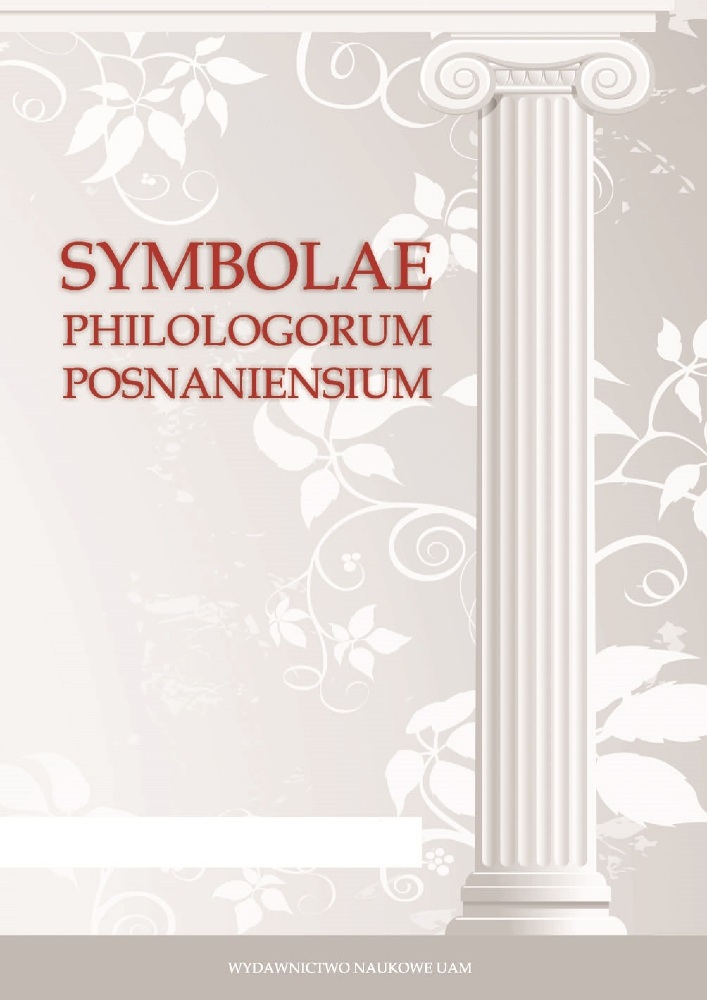Abstrakt
In the following article I present my own concept for interpreting Seneca’s Phaedra, demonstrating that the action takes place in three distinct settings: that of the royal palace (DOMUS), which is the domain of Phaedra’s actions, that of the city of Athens (URBS), which is the realm of Theseus and the Nurse, and that of the forest (SILVAE), which constitutes the world of Hippolytus. In the second part of the article I propose to arrange the stage in a way that takes the proposed settings into account.Bibliografia
Primary sources:
Coffey, Mayer1990: Seneca, Phaedra, Ed. by Coffey, M. , Mayer, R. 1990. Cambridge.
Rushton Fairclough 1936: Horace, Satires, Epistles and Ars poetica, with an English translation by Rushton Fairclough, H. 1936., Cambridge, Mass. Harvard University Press.
Grimal 1965 : Grimal, P. 1965 (ed.), L. Annaei Senecae Phaedra, Paris.
Rushton Fairclough 1936: Horace, Satires, Epistles and Ars poetica, with an English translation by H. Rushton Fairclough, H. 1936. Cambridge, Mass. Harvard University Press 465–7.
Miller 1917: Seneca, Tragedies. Transl. by F. J. Miller. Loeb Classical Library Volumes. Cambridge, MA, Harvard University Press; London, William Heinemann Ltd.
Secondary sources:
Axer 1991: Axer, J. 1991. “Amfiteatr w teatrze, czyli prolog do “Fedry” Seneki.” In Axer, J., Filolog w teatrze. Warszawa.
Boissier 1861: Boissier, G. 1861. Les tragédies de Sénèque ont-elles été représentées, Paris.
Boyle 1997: Boyle, A. J. 1997. Tragic Seneca: An essay in the theatrical tradition, London–New York.
Calder 1975: Calder, W. M. 1975. ‘The Size of the Chorus in Seneca’s Agamemnon, Classical Philology LXX.
Duckworth 1952: Duckworth, G.E. 1952. The Nature of Roman Comedy: A Study in Popular Entertainment, Princeton.
Fortey, Glucker 1975: Fortey, S., Glucker, J. 1975. “Actus Tragicus: Seneca on the Stage.” Latomus XXXIV: 699–715.
Frank 1995: Frank, M. 1995. Seneca’s Phoenissae: Introduction and Commentary, Leiden.
Gomme, Sandbach 1973: Ed. by A. W. Gomme, F. H. Sandbach. Oxford, Menander: a Commentary, Oxford.
Grimal 1965: Grimal, P (ed.), L. Annaei Senecae Phaedra, Paris.
Herington 1966: Herington, C.J. 1966. “Senecan Tragedy”, Arion V: 422–71.
Kragelund 1999: Kragelund, P. 1999. “Senecan Tragedy: Back on Stage?” Classica et Medievalia L: 235–247.
Marshall 2006: Marshall, C.W. 2006. The Stagecraft and Performance of Roman Comedy, Cambridge.
Sear 2006: Sear, F. 2006. Roman Theatres: An Architectural Study, Oxford.
Seidensticker 1969: Seidensticker, B. 1969. Die Gesprächsverdichtung in den Tragödien Senecas, Heidelberg.
Sutton, D. F. 1986: Sutton, D. F. 1986. Seneca on the Stage, Leiden.
Tarrant 1978: Tarrant, R. J. 1978. ‘Senecan Drama and its Antecedents’, Harvard Studies in Classical Philology LXXXII: 217–254.
Wesołowska 1998: Wesołowska, E. 1998. Prologi tragedii Seneki w świetle komunikacji literackiej, Poznań.
Zwierlein 1966: Z wierlein, O. 1966. Die Rezitationsdramen Senecas, Meisenheim n. Glan.
Licencja
